Podcast Project: Analyzing Cross-Cultural Management in Tanzania
VerifiedAdded on 2023/04/17
|10
|1948
|212
Project
AI Summary
This project involves a scripted podcast and supporting analysis based on a case study of Hydro Generation (HG) in Tanzania. The assignment focuses on the challenges of cross-cultural management, particularly the actions of manager Brett Jones and his adoption of Tanzanian business practices, including nepotism in hiring. The script addresses the problems within the case study, relating them to topics covered in lectures, including organizational structure, and Hofstede's cultural dimensions (power distance, individualism vs. collectivism, masculinity, uncertainty avoidance, and long-term orientation). The reflective report examines the advantages and disadvantages of Jones's approach, considering the impact on HG's organizational culture and the potential repercussions. The project also provides insights into the application of different organizational structures (functional, divisional, and matrix) within the context of a multinational corporation. The aim is to provide a comprehensive understanding of how cultural differences and management practices can affect project success.
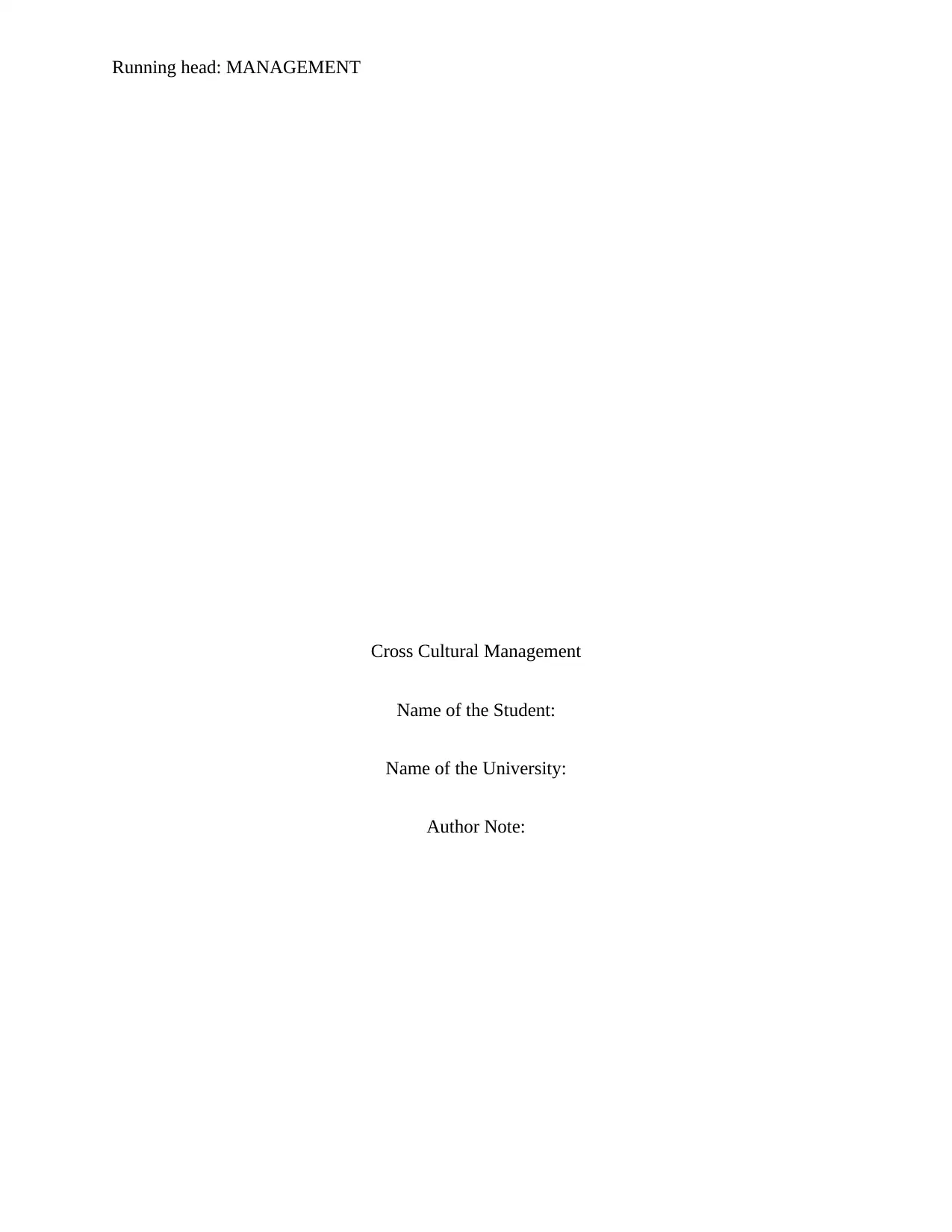
Running head: MANAGEMENT
Cross Cultural Management
Name of the Student:
Name of the University:
Author Note:
Cross Cultural Management
Name of the Student:
Name of the University:
Author Note:
Paraphrase This Document
Need a fresh take? Get an instant paraphrase of this document with our AI Paraphraser
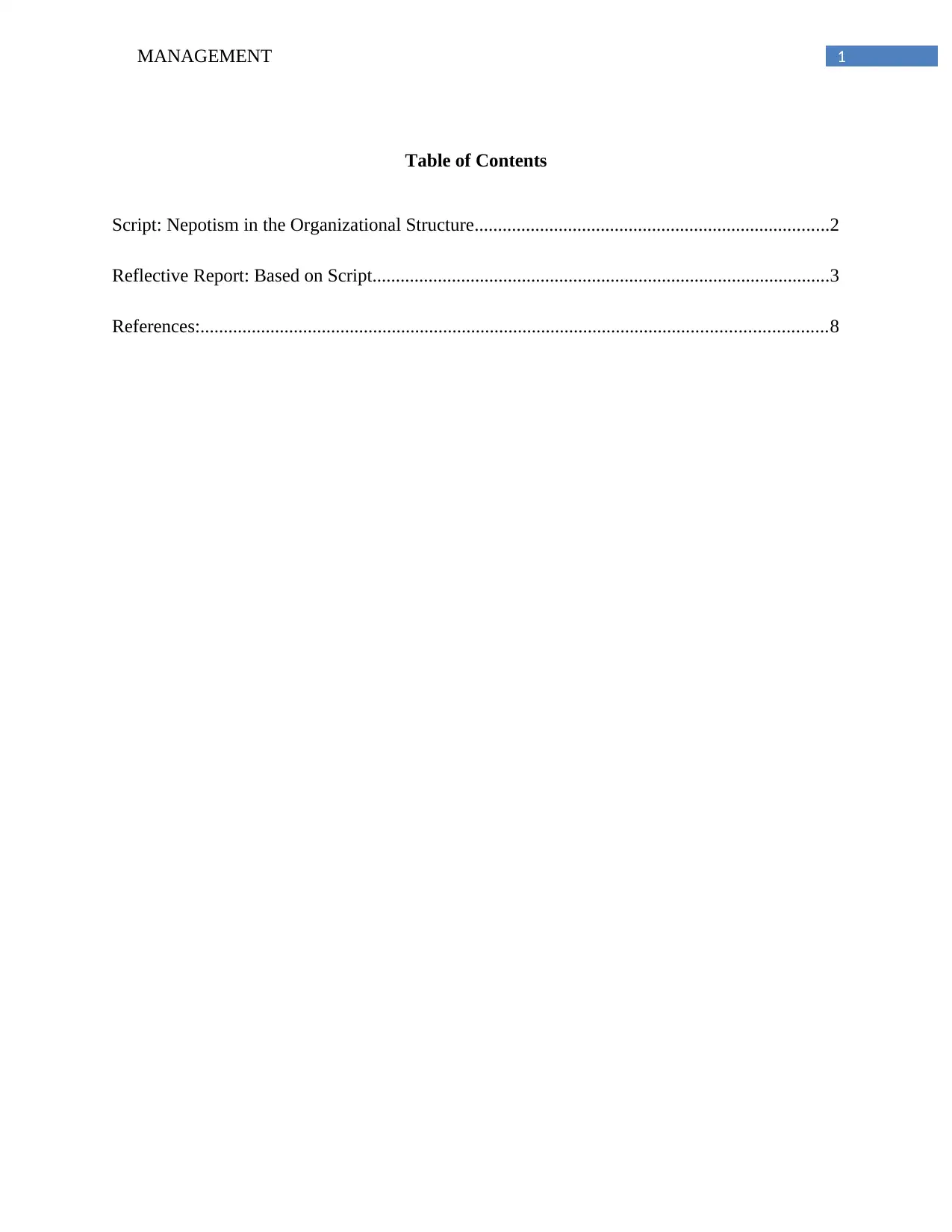
1MANAGEMENT
Table of Contents
Script: Nepotism in the Organizational Structure............................................................................2
Reflective Report: Based on Script..................................................................................................3
References:......................................................................................................................................8
Table of Contents
Script: Nepotism in the Organizational Structure............................................................................2
Reflective Report: Based on Script..................................................................................................3
References:......................................................................................................................................8
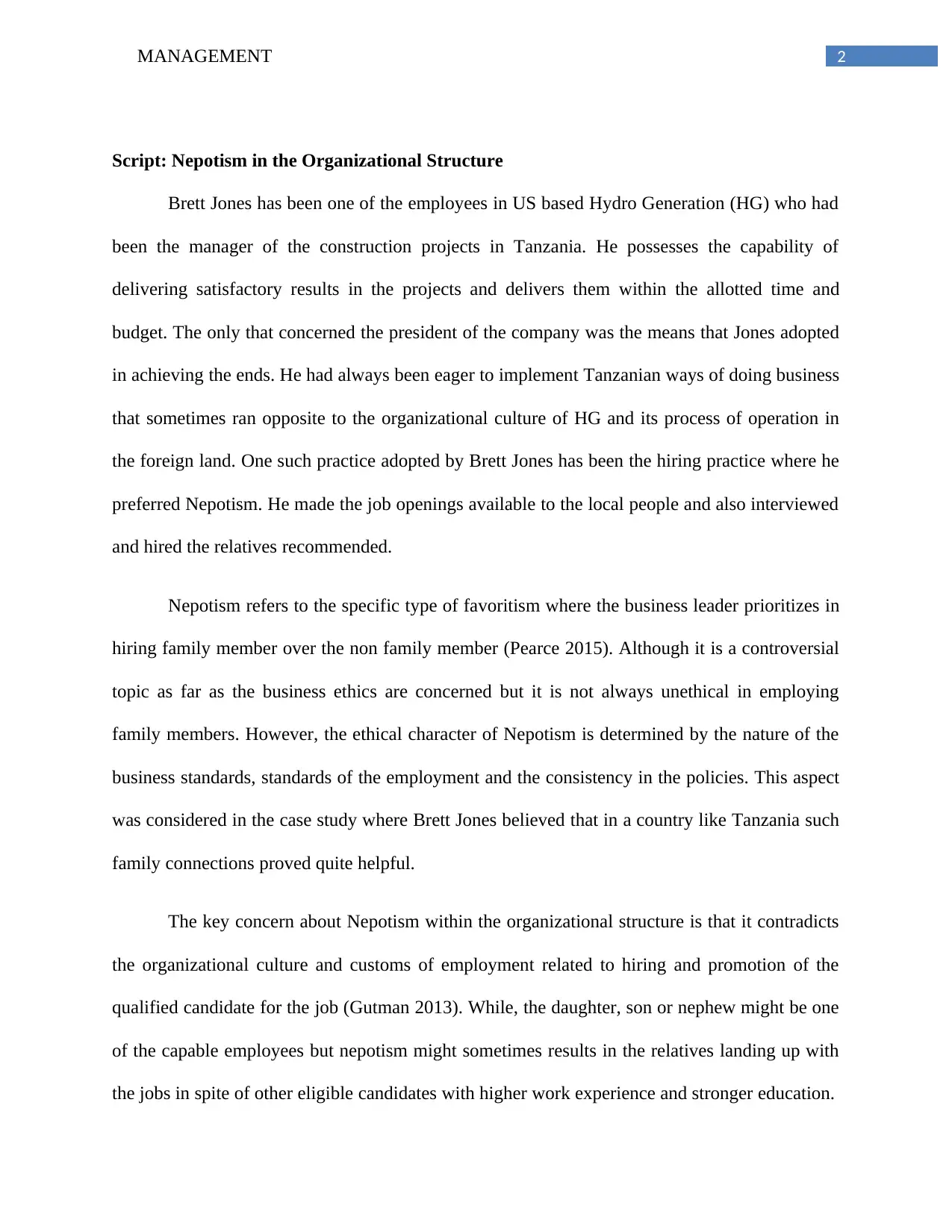
2MANAGEMENT
Script: Nepotism in the Organizational Structure
Brett Jones has been one of the employees in US based Hydro Generation (HG) who had
been the manager of the construction projects in Tanzania. He possesses the capability of
delivering satisfactory results in the projects and delivers them within the allotted time and
budget. The only that concerned the president of the company was the means that Jones adopted
in achieving the ends. He had always been eager to implement Tanzanian ways of doing business
that sometimes ran opposite to the organizational culture of HG and its process of operation in
the foreign land. One such practice adopted by Brett Jones has been the hiring practice where he
preferred Nepotism. He made the job openings available to the local people and also interviewed
and hired the relatives recommended.
Nepotism refers to the specific type of favoritism where the business leader prioritizes in
hiring family member over the non family member (Pearce 2015). Although it is a controversial
topic as far as the business ethics are concerned but it is not always unethical in employing
family members. However, the ethical character of Nepotism is determined by the nature of the
business standards, standards of the employment and the consistency in the policies. This aspect
was considered in the case study where Brett Jones believed that in a country like Tanzania such
family connections proved quite helpful.
The key concern about Nepotism within the organizational structure is that it contradicts
the organizational culture and customs of employment related to hiring and promotion of the
qualified candidate for the job (Gutman 2013). While, the daughter, son or nephew might be one
of the capable employees but nepotism might sometimes results in the relatives landing up with
the jobs in spite of other eligible candidates with higher work experience and stronger education.
Script: Nepotism in the Organizational Structure
Brett Jones has been one of the employees in US based Hydro Generation (HG) who had
been the manager of the construction projects in Tanzania. He possesses the capability of
delivering satisfactory results in the projects and delivers them within the allotted time and
budget. The only that concerned the president of the company was the means that Jones adopted
in achieving the ends. He had always been eager to implement Tanzanian ways of doing business
that sometimes ran opposite to the organizational culture of HG and its process of operation in
the foreign land. One such practice adopted by Brett Jones has been the hiring practice where he
preferred Nepotism. He made the job openings available to the local people and also interviewed
and hired the relatives recommended.
Nepotism refers to the specific type of favoritism where the business leader prioritizes in
hiring family member over the non family member (Pearce 2015). Although it is a controversial
topic as far as the business ethics are concerned but it is not always unethical in employing
family members. However, the ethical character of Nepotism is determined by the nature of the
business standards, standards of the employment and the consistency in the policies. This aspect
was considered in the case study where Brett Jones believed that in a country like Tanzania such
family connections proved quite helpful.
The key concern about Nepotism within the organizational structure is that it contradicts
the organizational culture and customs of employment related to hiring and promotion of the
qualified candidate for the job (Gutman 2013). While, the daughter, son or nephew might be one
of the capable employees but nepotism might sometimes results in the relatives landing up with
the jobs in spite of other eligible candidates with higher work experience and stronger education.
⊘ This is a preview!⊘
Do you want full access?
Subscribe today to unlock all pages.

Trusted by 1+ million students worldwide
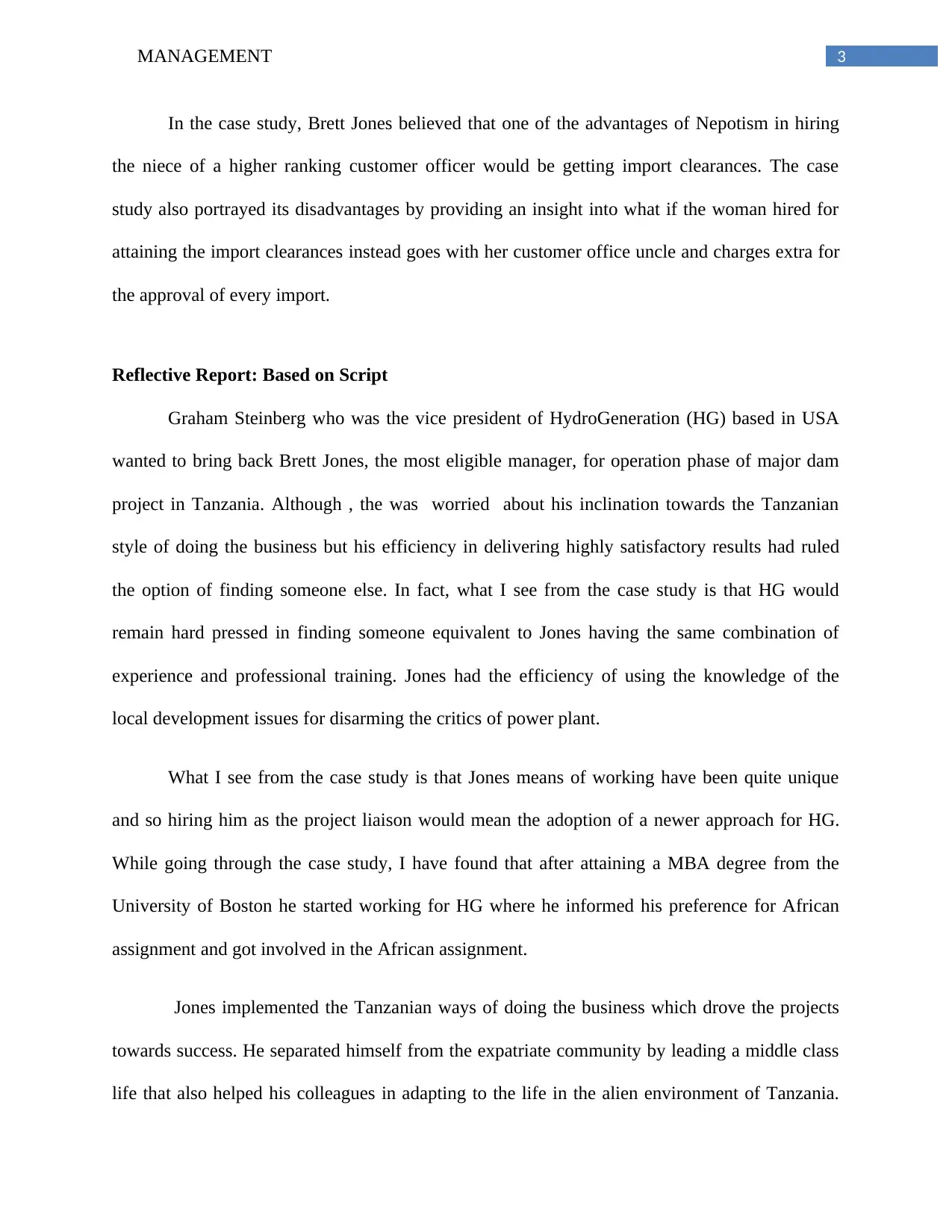
3MANAGEMENT
In the case study, Brett Jones believed that one of the advantages of Nepotism in hiring
the niece of a higher ranking customer officer would be getting import clearances. The case
study also portrayed its disadvantages by providing an insight into what if the woman hired for
attaining the import clearances instead goes with her customer office uncle and charges extra for
the approval of every import.
Reflective Report: Based on Script
Graham Steinberg who was the vice president of HydroGeneration (HG) based in USA
wanted to bring back Brett Jones, the most eligible manager, for operation phase of major dam
project in Tanzania. Although , the was worried about his inclination towards the Tanzanian
style of doing the business but his efficiency in delivering highly satisfactory results had ruled
the option of finding someone else. In fact, what I see from the case study is that HG would
remain hard pressed in finding someone equivalent to Jones having the same combination of
experience and professional training. Jones had the efficiency of using the knowledge of the
local development issues for disarming the critics of power plant.
What I see from the case study is that Jones means of working have been quite unique
and so hiring him as the project liaison would mean the adoption of a newer approach for HG.
While going through the case study, I have found that after attaining a MBA degree from the
University of Boston he started working for HG where he informed his preference for African
assignment and got involved in the African assignment.
Jones implemented the Tanzanian ways of doing the business which drove the projects
towards success. He separated himself from the expatriate community by leading a middle class
life that also helped his colleagues in adapting to the life in the alien environment of Tanzania.
In the case study, Brett Jones believed that one of the advantages of Nepotism in hiring
the niece of a higher ranking customer officer would be getting import clearances. The case
study also portrayed its disadvantages by providing an insight into what if the woman hired for
attaining the import clearances instead goes with her customer office uncle and charges extra for
the approval of every import.
Reflective Report: Based on Script
Graham Steinberg who was the vice president of HydroGeneration (HG) based in USA
wanted to bring back Brett Jones, the most eligible manager, for operation phase of major dam
project in Tanzania. Although , the was worried about his inclination towards the Tanzanian
style of doing the business but his efficiency in delivering highly satisfactory results had ruled
the option of finding someone else. In fact, what I see from the case study is that HG would
remain hard pressed in finding someone equivalent to Jones having the same combination of
experience and professional training. Jones had the efficiency of using the knowledge of the
local development issues for disarming the critics of power plant.
What I see from the case study is that Jones means of working have been quite unique
and so hiring him as the project liaison would mean the adoption of a newer approach for HG.
While going through the case study, I have found that after attaining a MBA degree from the
University of Boston he started working for HG where he informed his preference for African
assignment and got involved in the African assignment.
Jones implemented the Tanzanian ways of doing the business which drove the projects
towards success. He separated himself from the expatriate community by leading a middle class
life that also helped his colleagues in adapting to the life in the alien environment of Tanzania.
Paraphrase This Document
Need a fresh take? Get an instant paraphrase of this document with our AI Paraphraser
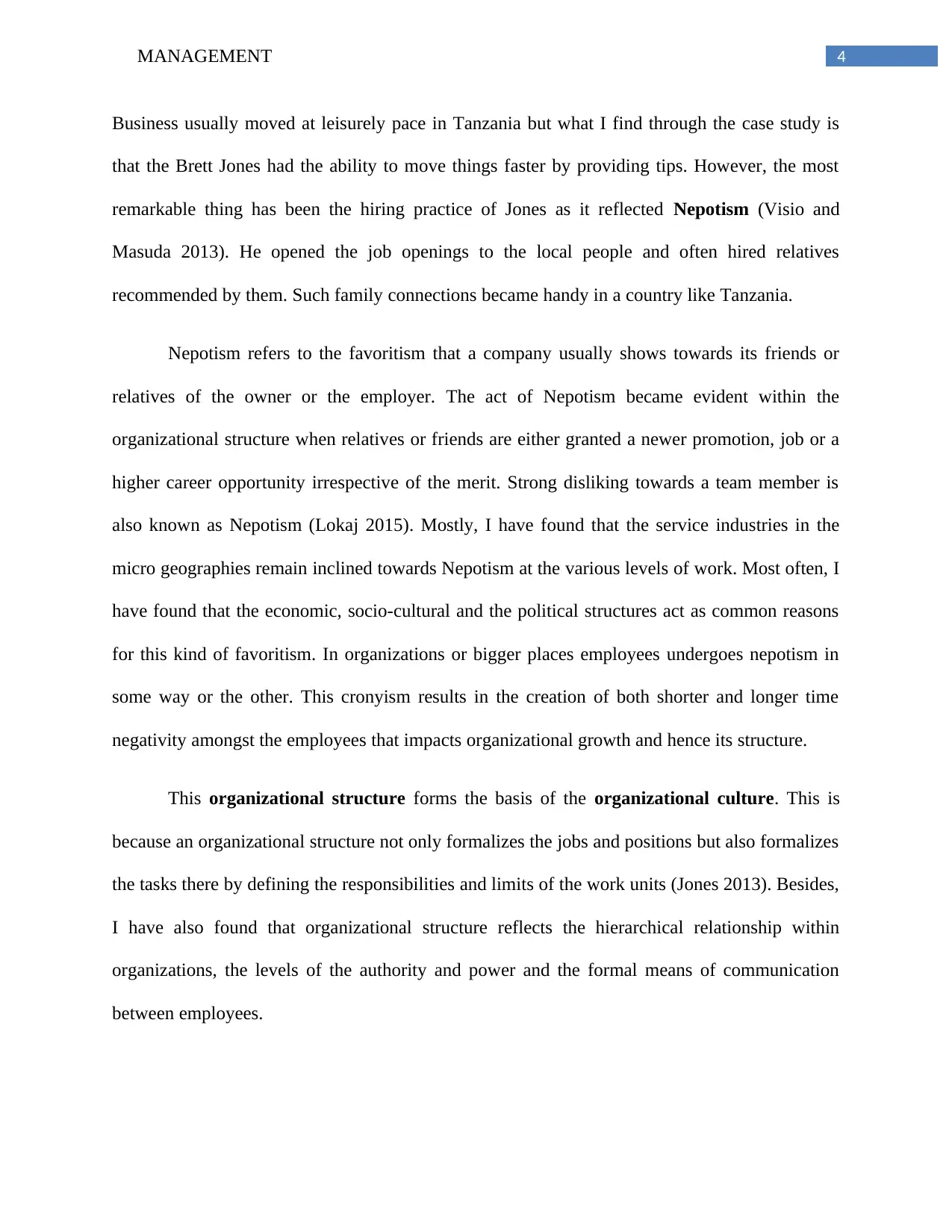
4MANAGEMENT
Business usually moved at leisurely pace in Tanzania but what I find through the case study is
that the Brett Jones had the ability to move things faster by providing tips. However, the most
remarkable thing has been the hiring practice of Jones as it reflected Nepotism (Visio and
Masuda 2013). He opened the job openings to the local people and often hired relatives
recommended by them. Such family connections became handy in a country like Tanzania.
Nepotism refers to the favoritism that a company usually shows towards its friends or
relatives of the owner or the employer. The act of Nepotism became evident within the
organizational structure when relatives or friends are either granted a newer promotion, job or a
higher career opportunity irrespective of the merit. Strong disliking towards a team member is
also known as Nepotism (Lokaj 2015). Mostly, I have found that the service industries in the
micro geographies remain inclined towards Nepotism at the various levels of work. Most often, I
have found that the economic, socio-cultural and the political structures act as common reasons
for this kind of favoritism. In organizations or bigger places employees undergoes nepotism in
some way or the other. This cronyism results in the creation of both shorter and longer time
negativity amongst the employees that impacts organizational growth and hence its structure.
This organizational structure forms the basis of the organizational culture. This is
because an organizational structure not only formalizes the jobs and positions but also formalizes
the tasks there by defining the responsibilities and limits of the work units (Jones 2013). Besides,
I have also found that organizational structure reflects the hierarchical relationship within
organizations, the levels of the authority and power and the formal means of communication
between employees.
Business usually moved at leisurely pace in Tanzania but what I find through the case study is
that the Brett Jones had the ability to move things faster by providing tips. However, the most
remarkable thing has been the hiring practice of Jones as it reflected Nepotism (Visio and
Masuda 2013). He opened the job openings to the local people and often hired relatives
recommended by them. Such family connections became handy in a country like Tanzania.
Nepotism refers to the favoritism that a company usually shows towards its friends or
relatives of the owner or the employer. The act of Nepotism became evident within the
organizational structure when relatives or friends are either granted a newer promotion, job or a
higher career opportunity irrespective of the merit. Strong disliking towards a team member is
also known as Nepotism (Lokaj 2015). Mostly, I have found that the service industries in the
micro geographies remain inclined towards Nepotism at the various levels of work. Most often, I
have found that the economic, socio-cultural and the political structures act as common reasons
for this kind of favoritism. In organizations or bigger places employees undergoes nepotism in
some way or the other. This cronyism results in the creation of both shorter and longer time
negativity amongst the employees that impacts organizational growth and hence its structure.
This organizational structure forms the basis of the organizational culture. This is
because an organizational structure not only formalizes the jobs and positions but also formalizes
the tasks there by defining the responsibilities and limits of the work units (Jones 2013). Besides,
I have also found that organizational structure reflects the hierarchical relationship within
organizations, the levels of the authority and power and the formal means of communication
between employees.
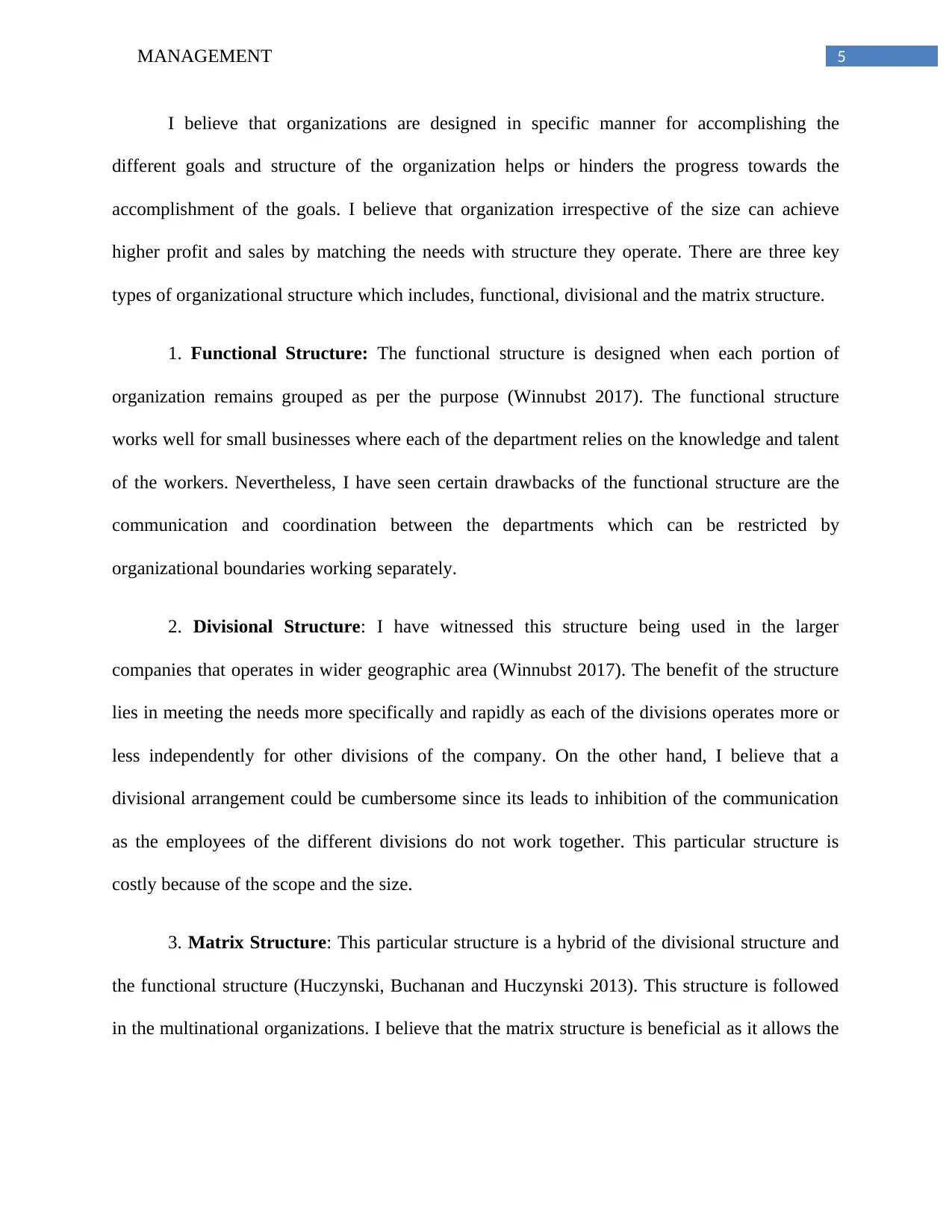
5MANAGEMENT
I believe that organizations are designed in specific manner for accomplishing the
different goals and structure of the organization helps or hinders the progress towards the
accomplishment of the goals. I believe that organization irrespective of the size can achieve
higher profit and sales by matching the needs with structure they operate. There are three key
types of organizational structure which includes, functional, divisional and the matrix structure.
1. Functional Structure: The functional structure is designed when each portion of
organization remains grouped as per the purpose (Winnubst 2017). The functional structure
works well for small businesses where each of the department relies on the knowledge and talent
of the workers. Nevertheless, I have seen certain drawbacks of the functional structure are the
communication and coordination between the departments which can be restricted by
organizational boundaries working separately.
2. Divisional Structure: I have witnessed this structure being used in the larger
companies that operates in wider geographic area (Winnubst 2017). The benefit of the structure
lies in meeting the needs more specifically and rapidly as each of the divisions operates more or
less independently for other divisions of the company. On the other hand, I believe that a
divisional arrangement could be cumbersome since its leads to inhibition of the communication
as the employees of the different divisions do not work together. This particular structure is
costly because of the scope and the size.
3. Matrix Structure: This particular structure is a hybrid of the divisional structure and
the functional structure (Huczynski, Buchanan and Huczynski 2013). This structure is followed
in the multinational organizations. I believe that the matrix structure is beneficial as it allows the
I believe that organizations are designed in specific manner for accomplishing the
different goals and structure of the organization helps or hinders the progress towards the
accomplishment of the goals. I believe that organization irrespective of the size can achieve
higher profit and sales by matching the needs with structure they operate. There are three key
types of organizational structure which includes, functional, divisional and the matrix structure.
1. Functional Structure: The functional structure is designed when each portion of
organization remains grouped as per the purpose (Winnubst 2017). The functional structure
works well for small businesses where each of the department relies on the knowledge and talent
of the workers. Nevertheless, I have seen certain drawbacks of the functional structure are the
communication and coordination between the departments which can be restricted by
organizational boundaries working separately.
2. Divisional Structure: I have witnessed this structure being used in the larger
companies that operates in wider geographic area (Winnubst 2017). The benefit of the structure
lies in meeting the needs more specifically and rapidly as each of the divisions operates more or
less independently for other divisions of the company. On the other hand, I believe that a
divisional arrangement could be cumbersome since its leads to inhibition of the communication
as the employees of the different divisions do not work together. This particular structure is
costly because of the scope and the size.
3. Matrix Structure: This particular structure is a hybrid of the divisional structure and
the functional structure (Huczynski, Buchanan and Huczynski 2013). This structure is followed
in the multinational organizations. I believe that the matrix structure is beneficial as it allows the
⊘ This is a preview!⊘
Do you want full access?
Subscribe today to unlock all pages.

Trusted by 1+ million students worldwide
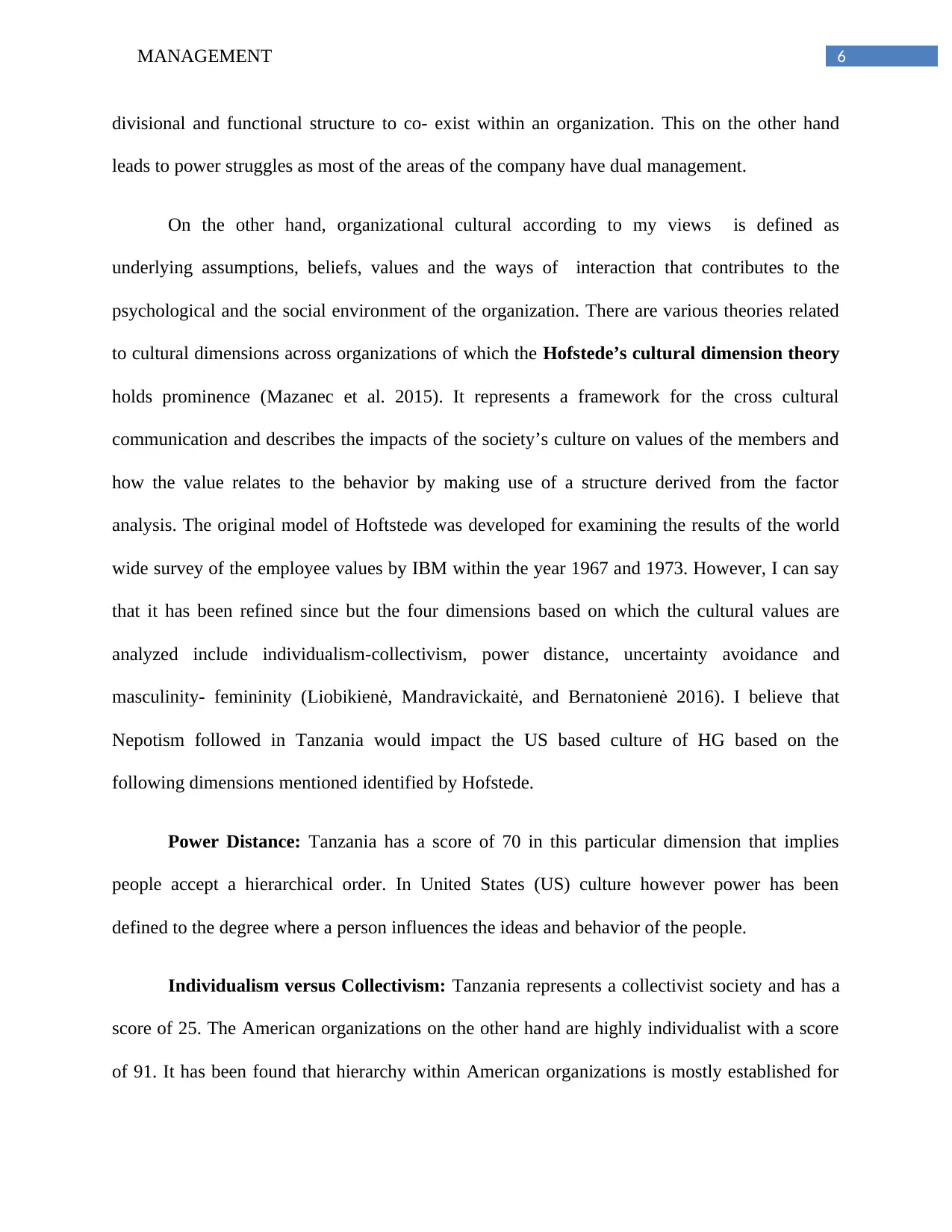
6MANAGEMENT
divisional and functional structure to co- exist within an organization. This on the other hand
leads to power struggles as most of the areas of the company have dual management.
On the other hand, organizational cultural according to my views is defined as
underlying assumptions, beliefs, values and the ways of interaction that contributes to the
psychological and the social environment of the organization. There are various theories related
to cultural dimensions across organizations of which the Hofstede’s cultural dimension theory
holds prominence (Mazanec et al. 2015). It represents a framework for the cross cultural
communication and describes the impacts of the society’s culture on values of the members and
how the value relates to the behavior by making use of a structure derived from the factor
analysis. The original model of Hoftstede was developed for examining the results of the world
wide survey of the employee values by IBM within the year 1967 and 1973. However, I can say
that it has been refined since but the four dimensions based on which the cultural values are
analyzed include individualism-collectivism, power distance, uncertainty avoidance and
masculinity- femininity (Liobikienė, Mandravickaitė, and Bernatonienė 2016). I believe that
Nepotism followed in Tanzania would impact the US based culture of HG based on the
following dimensions mentioned identified by Hofstede.
Power Distance: Tanzania has a score of 70 in this particular dimension that implies
people accept a hierarchical order. In United States (US) culture however power has been
defined to the degree where a person influences the ideas and behavior of the people.
Individualism versus Collectivism: Tanzania represents a collectivist society and has a
score of 25. The American organizations on the other hand are highly individualist with a score
of 91. It has been found that hierarchy within American organizations is mostly established for
divisional and functional structure to co- exist within an organization. This on the other hand
leads to power struggles as most of the areas of the company have dual management.
On the other hand, organizational cultural according to my views is defined as
underlying assumptions, beliefs, values and the ways of interaction that contributes to the
psychological and the social environment of the organization. There are various theories related
to cultural dimensions across organizations of which the Hofstede’s cultural dimension theory
holds prominence (Mazanec et al. 2015). It represents a framework for the cross cultural
communication and describes the impacts of the society’s culture on values of the members and
how the value relates to the behavior by making use of a structure derived from the factor
analysis. The original model of Hoftstede was developed for examining the results of the world
wide survey of the employee values by IBM within the year 1967 and 1973. However, I can say
that it has been refined since but the four dimensions based on which the cultural values are
analyzed include individualism-collectivism, power distance, uncertainty avoidance and
masculinity- femininity (Liobikienė, Mandravickaitė, and Bernatonienė 2016). I believe that
Nepotism followed in Tanzania would impact the US based culture of HG based on the
following dimensions mentioned identified by Hofstede.
Power Distance: Tanzania has a score of 70 in this particular dimension that implies
people accept a hierarchical order. In United States (US) culture however power has been
defined to the degree where a person influences the ideas and behavior of the people.
Individualism versus Collectivism: Tanzania represents a collectivist society and has a
score of 25. The American organizations on the other hand are highly individualist with a score
of 91. It has been found that hierarchy within American organizations is mostly established for
Paraphrase This Document
Need a fresh take? Get an instant paraphrase of this document with our AI Paraphraser
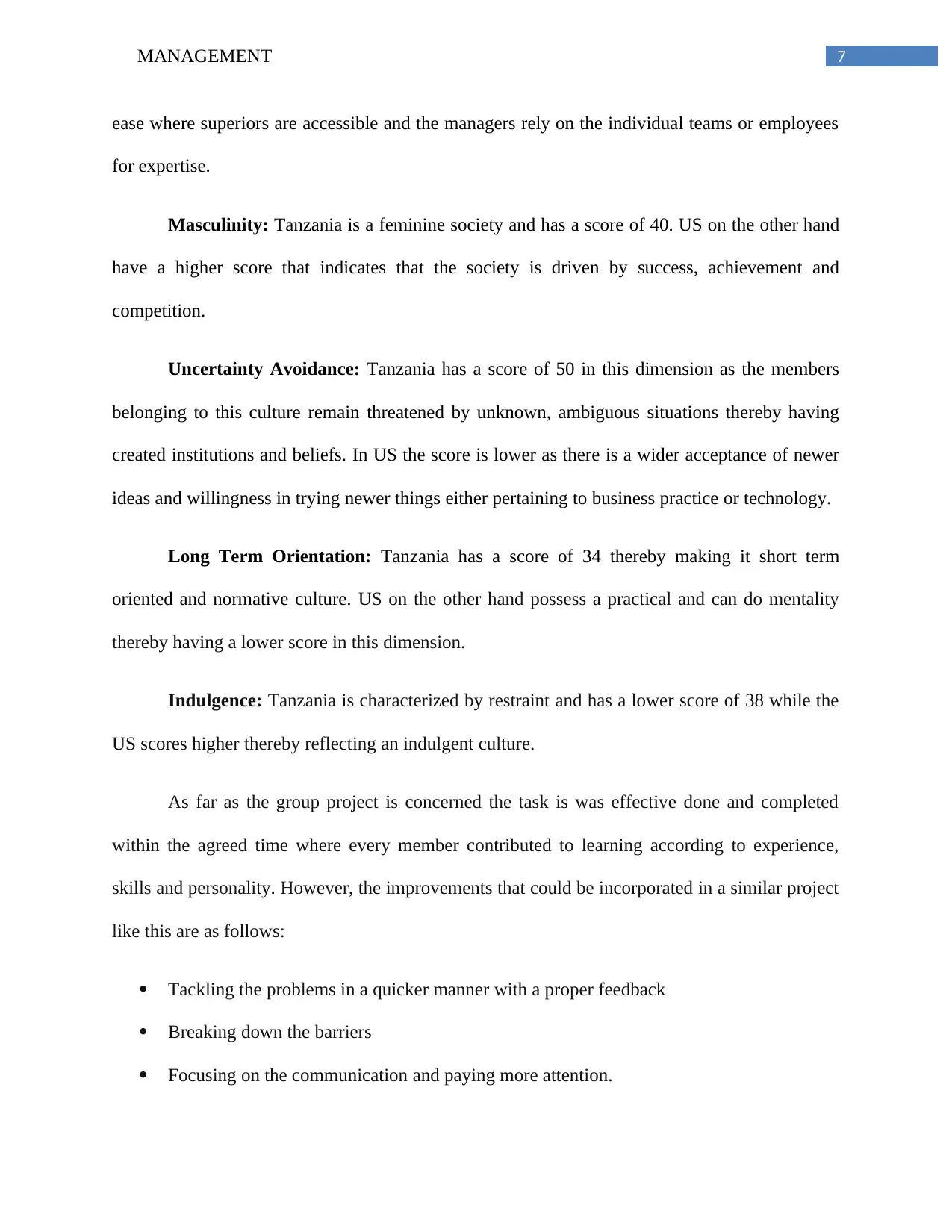
7MANAGEMENT
ease where superiors are accessible and the managers rely on the individual teams or employees
for expertise.
Masculinity: Tanzania is a feminine society and has a score of 40. US on the other hand
have a higher score that indicates that the society is driven by success, achievement and
competition.
Uncertainty Avoidance: Tanzania has a score of 50 in this dimension as the members
belonging to this culture remain threatened by unknown, ambiguous situations thereby having
created institutions and beliefs. In US the score is lower as there is a wider acceptance of newer
ideas and willingness in trying newer things either pertaining to business practice or technology.
Long Term Orientation: Tanzania has a score of 34 thereby making it short term
oriented and normative culture. US on the other hand possess a practical and can do mentality
thereby having a lower score in this dimension.
Indulgence: Tanzania is characterized by restraint and has a lower score of 38 while the
US scores higher thereby reflecting an indulgent culture.
As far as the group project is concerned the task is was effective done and completed
within the agreed time where every member contributed to learning according to experience,
skills and personality. However, the improvements that could be incorporated in a similar project
like this are as follows:
Tackling the problems in a quicker manner with a proper feedback
Breaking down the barriers
Focusing on the communication and paying more attention.
ease where superiors are accessible and the managers rely on the individual teams or employees
for expertise.
Masculinity: Tanzania is a feminine society and has a score of 40. US on the other hand
have a higher score that indicates that the society is driven by success, achievement and
competition.
Uncertainty Avoidance: Tanzania has a score of 50 in this dimension as the members
belonging to this culture remain threatened by unknown, ambiguous situations thereby having
created institutions and beliefs. In US the score is lower as there is a wider acceptance of newer
ideas and willingness in trying newer things either pertaining to business practice or technology.
Long Term Orientation: Tanzania has a score of 34 thereby making it short term
oriented and normative culture. US on the other hand possess a practical and can do mentality
thereby having a lower score in this dimension.
Indulgence: Tanzania is characterized by restraint and has a lower score of 38 while the
US scores higher thereby reflecting an indulgent culture.
As far as the group project is concerned the task is was effective done and completed
within the agreed time where every member contributed to learning according to experience,
skills and personality. However, the improvements that could be incorporated in a similar project
like this are as follows:
Tackling the problems in a quicker manner with a proper feedback
Breaking down the barriers
Focusing on the communication and paying more attention.
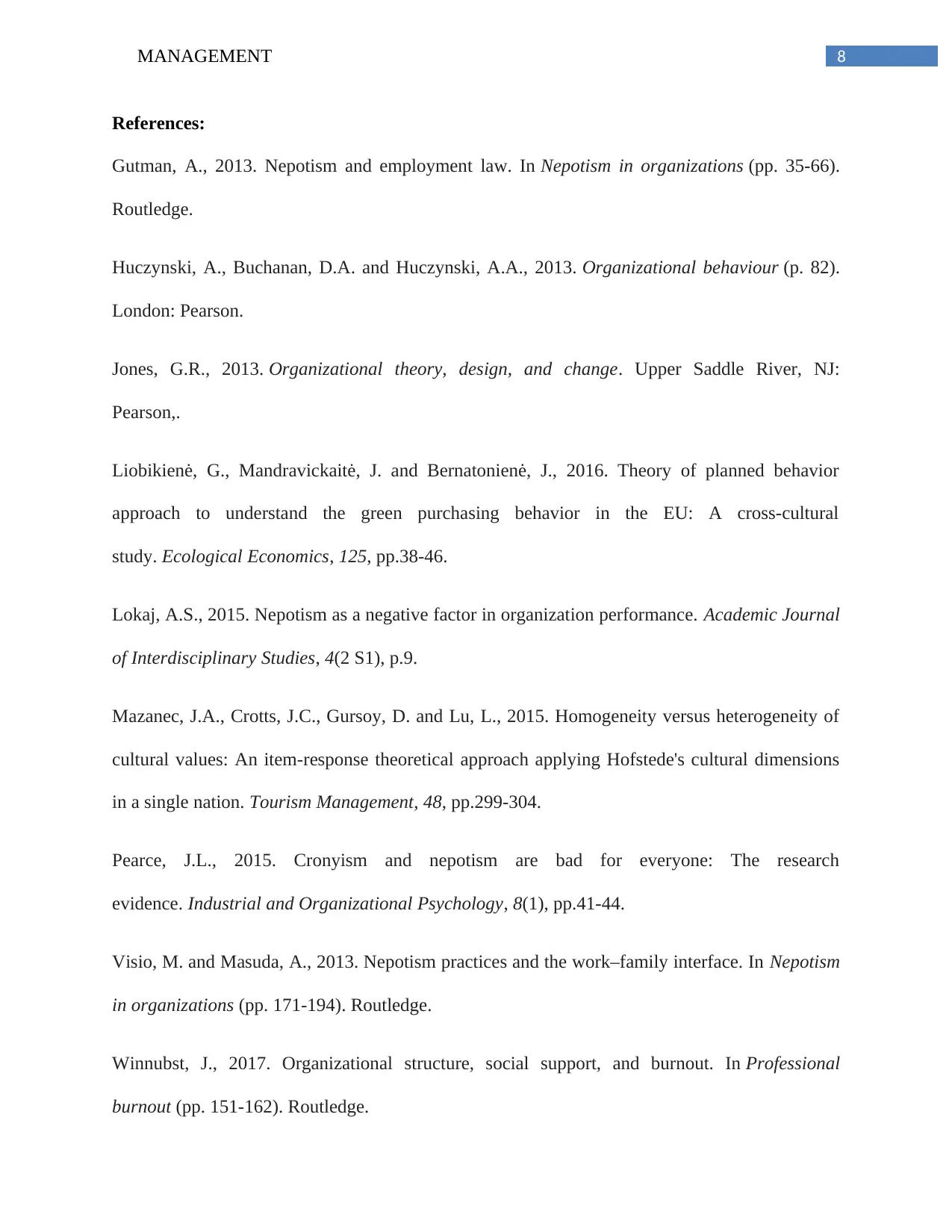
8MANAGEMENT
References:
Gutman, A., 2013. Nepotism and employment law. In Nepotism in organizations (pp. 35-66).
Routledge.
Huczynski, A., Buchanan, D.A. and Huczynski, A.A., 2013. Organizational behaviour (p. 82).
London: Pearson.
Jones, G.R., 2013. Organizational theory, design, and change. Upper Saddle River, NJ:
Pearson,.
Liobikienė, G., Mandravickaitė, J. and Bernatonienė, J., 2016. Theory of planned behavior
approach to understand the green purchasing behavior in the EU: A cross-cultural
study. Ecological Economics, 125, pp.38-46.
Lokaj, A.S., 2015. Nepotism as a negative factor in organization performance. Academic Journal
of Interdisciplinary Studies, 4(2 S1), p.9.
Mazanec, J.A., Crotts, J.C., Gursoy, D. and Lu, L., 2015. Homogeneity versus heterogeneity of
cultural values: An item-response theoretical approach applying Hofstede's cultural dimensions
in a single nation. Tourism Management, 48, pp.299-304.
Pearce, J.L., 2015. Cronyism and nepotism are bad for everyone: The research
evidence. Industrial and Organizational Psychology, 8(1), pp.41-44.
Visio, M. and Masuda, A., 2013. Nepotism practices and the work–family interface. In Nepotism
in organizations (pp. 171-194). Routledge.
Winnubst, J., 2017. Organizational structure, social support, and burnout. In Professional
burnout (pp. 151-162). Routledge.
References:
Gutman, A., 2013. Nepotism and employment law. In Nepotism in organizations (pp. 35-66).
Routledge.
Huczynski, A., Buchanan, D.A. and Huczynski, A.A., 2013. Organizational behaviour (p. 82).
London: Pearson.
Jones, G.R., 2013. Organizational theory, design, and change. Upper Saddle River, NJ:
Pearson,.
Liobikienė, G., Mandravickaitė, J. and Bernatonienė, J., 2016. Theory of planned behavior
approach to understand the green purchasing behavior in the EU: A cross-cultural
study. Ecological Economics, 125, pp.38-46.
Lokaj, A.S., 2015. Nepotism as a negative factor in organization performance. Academic Journal
of Interdisciplinary Studies, 4(2 S1), p.9.
Mazanec, J.A., Crotts, J.C., Gursoy, D. and Lu, L., 2015. Homogeneity versus heterogeneity of
cultural values: An item-response theoretical approach applying Hofstede's cultural dimensions
in a single nation. Tourism Management, 48, pp.299-304.
Pearce, J.L., 2015. Cronyism and nepotism are bad for everyone: The research
evidence. Industrial and Organizational Psychology, 8(1), pp.41-44.
Visio, M. and Masuda, A., 2013. Nepotism practices and the work–family interface. In Nepotism
in organizations (pp. 171-194). Routledge.
Winnubst, J., 2017. Organizational structure, social support, and burnout. In Professional
burnout (pp. 151-162). Routledge.
⊘ This is a preview!⊘
Do you want full access?
Subscribe today to unlock all pages.

Trusted by 1+ million students worldwide

9MANAGEMENT
1 out of 10
Related Documents
Your All-in-One AI-Powered Toolkit for Academic Success.
+13062052269
info@desklib.com
Available 24*7 on WhatsApp / Email
![[object Object]](/_next/static/media/star-bottom.7253800d.svg)
Unlock your academic potential
Copyright © 2020–2025 A2Z Services. All Rights Reserved. Developed and managed by ZUCOL.





